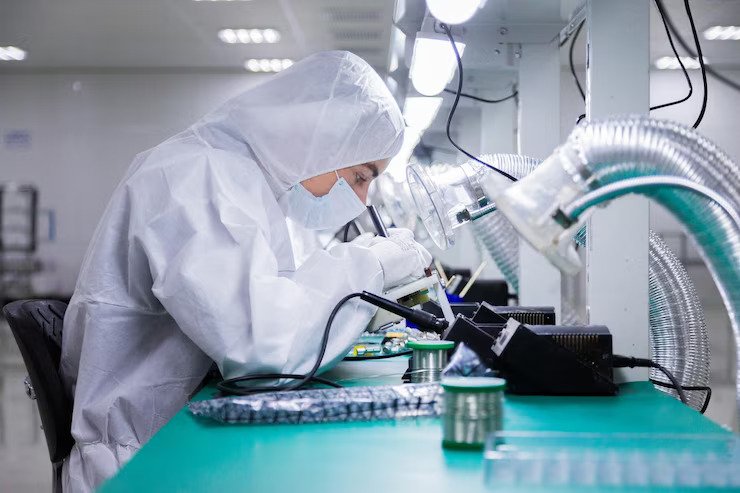How Atomic Absorption Spectroscopy Is Revolutionizing Quality Control In Manufacturing?
5 Mins Read
Published on: 14 March 2023
Last Updated on: 06 September 2024

toc impalement
The aas meaning is Atomic Absorption Spectroscopy.
Atomic Absorption Spectroscopy (AAS) is revolutionizing quality control in the manufacturing industry. This cutting-edge technology has enabled manufacturers to quickly and accurately assess product quality without relying on time-consuming traditional testing methods.
In this blog post, we will discuss five ways AAS revolutionizes quality control in the manufacturing industry, including improved accuracy and speed, reduced costs, and enhanced safety, with examples of absorption.
By using AAS like Agilent atomic absorption spectroscopy, manufacturers can consistently produce high-quality products while reducing costs and improving overall safety.
AAS Can Test For A Wide Range Of Metals
Atomic absorption can test for various metals, including iron, copper, aluminum, lead, and nickel. These different metals make detecting any potential problems or contaminants in the production process possible. This ensures that manufacturers are producing products with consistent quality.
With AAS, the test sample is first vaporized and then passed through an atomization chamber. As the sample passes through the section, it is exposed to high temperatures and electromagnetic radiation. This radiation causes the atoms in the sample to absorb energy and transition from one energy state to another.
Flame atomic absorption spectroscopy is beneficial for manufacturers as it can test for a wide range of metals with a high degree of accuracy and precision.
Not only does this help manufacturers ensure product quality, but it also allows them to make sure that their products meet certain regulatory requirements or standards. In this way, it is a valuable tool for improving product quality while also saving time and money in the production process.
AAS Is More Sensitive Than Other Methods
Atomic absorption spectroscopy (AAS) is one of the most sensitive methods for testing metals and other elements in various materials. AAS is capable of detecting metals at concentrations as low as parts-per-million (ppm), which is significantly more sensitive than other conventional methods such as flame photometry or gravimetric analysis.
This increased sensitivity enables manufacturers to detect small changes in concentrations that could indicate a production issue or material defect. The improved accuracy of AAS also helps to reduce false-positive results that could lead to unnecessary process shutdowns or defective products. With AAS, manufacturers can monitor their quality control processes with greater confidence and accuracy.
AAS Can Be Used For In-Process Testing
Atomic absorption spectroscopy (AAS) can be used for the in-process testing of metals and other materials. This is a key benefit for manufacturers, as it allows them to test their products at any point in the production process.
With this method, manufacturers can be sure that their product meets their quality standards throughout the entire production cycle. In-process testing allows manufacturers to catch problems before they become expensive reworks, reducing the cost and improving the quality of the finished product.
In-process testing with AAS is also incredibly fast, allowing atomic spectroscopy manufacturers to make adjustments quickly and easily if needed. The sensitivity of the instrumentation allows even small changes in concentration to be detected and corrected quickly. This makes AAS an essential tool for any quality control process.
In-process testing with AAS can also provide valuable information about the manufacturing process itself. By measuring the concentrations of various elements in the sample at different stages of the process, manufacturers can gain insights into how different variables affect their product’s quality. This data can then be used to adjust the manufacturing process and improve the end result.
By using AAS for in-process testing, manufacturers can ensure that their products meet their quality standards without having to wait until after production is complete. This makes AAS an invaluable tool for any quality control process.
Related: Ways Business Can Ensure Production Quality During Manufacturing
AAS Is Less Expensive Than Other Methods
Atomic absorption spectroscopy (AAS) is a cost-effective method for quality control in manufacturing. It is generally cheaper than other methods of testing metals and elements, such as X-ray fluorescence and inductively coupled plasma optical emission spectroscopy.
This makes AAS an attractive option for companies looking to save on costs while still ensuring their products meet quality standards. In addition, the ease of use and low running costs associated with AAS further reduce its overall cost.
With the right equipment and minimal maintenance, companies can quickly and easily conduct accurate tests with AAS. Therefore, AAS is an ideal choice for any company looking to maximize its budget while also ensuring product quality.
AAS Is Easy To Use
Atomic absorption spectroscopy is a reliable and easy-to-use method for quality control in manufacturing. The process of AAS is relatively simple and straightforward.
All it requires is to put a sample of the material into the AAS machine, press a few buttons, and wait for the results. It can be used in both laboratory and production settings, which makes it a great option for those looking to test their products quickly and accurately.
The AAS instrument itself is also quite simple. It has few moving parts and only requires minimal maintenance. This means that it is easy to operate and maintain, even for those with limited technical knowledge. Furthermore, the instrument is small enough to be portable, allowing it to be used in a variety of settings.
Overall, AAS is an incredibly useful tool for those looking for an accurate and efficient method for quality control in manufacturing. It is easy to use, requires minimal maintenance, and is highly sensitive. This makes it an excellent choice for companies looking to ensure their products meet the highest standards of quality.
The Future Of Quality Control With Atomic Absorption Spectroscopy
Atomic absorption spectroscopy (AAS) is an analytical system used to determine the concentrations of elements in the sample. The method employs an atomizer to vaporize the sample, passed through a light beam. The atoms in the sample absorb energy from the light, which is then measured by a detector.
AAS has long been used in manufacturing quality control applications, but recent technological advances have made it even more powerful and versatile. For example, new-generation AAS instruments can operate at much higher temperatures, allowing for greater sensitivity and lower detection limits. Additionally, multiple-element analysis is now possible with AAS, further expanding its utility in quality control applications.
AAS is poised to become even more important in quality control as manufacturers seek ways to improve product quality and reduce costs. The continued miniaturization of AAS instruments will make them more portable and affordable, while advances in data analysis software will enable faster and more accurate results. As a result, AAS will play an increasingly vital role in ensuring the quality of manufactured products.
Conclusion
Atomic absorption spectroscopy is a powerful tool that can help simplify and streamline the quality control process for manufacturers. With its accuracy and efficiency, it has revolutionized the way companies efficiently produce high-quality goods.
By using this technology like Agilent atomic absorption spectroscopy, manufacturers can save money by reducing waste production, increasing product consistency, and boosting overall customer satisfaction. All these advantages make atomic absorption spectroscopy a must-have for any manufacturing operation that wants to remain competitive in today’s market.
Read Also:


















Comments Are Closed For This Article